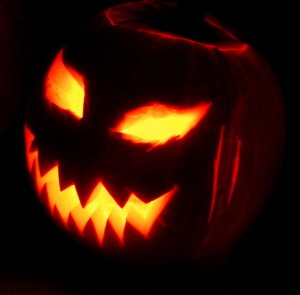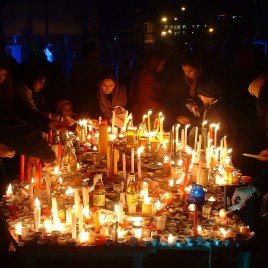 Here’s an interesting article highlighting some of the spirit of Halloween.
Here’s an interesting article highlighting some of the spirit of Halloween.
The History of Halloween or What is Samhain?
Author: Vivienne D’Avalon
Samhain, pronounced sow-wen, is a Celtic word meaning “summer’s end.” It is also the Irish Gaelic word for the month of November. Samhain is the last of three harvest festivals in the Celtic year, and it is the Celtic New Year. The Celts only recognized two seasons: summer, and winter. So, with the last harvest, the summer ends, and the cold, dark, dangerous days of winter begin. Any food that was not brought in from the fields by the end of the day on October 31, Samhain, was left in the fields and not eaten. It was considered to belong to the fairy folk at that point, and would make anyone sick who tried to eat it.
The food in the storerooms by this time was all the food you were going to get between this first day of winter and the coming spring. It had to last through the cold, dark winter months. Starvation was always a possibility. Livestock was slaughtered at this time, both to preserve meat for the winter months, and to cull the herd. With fewer animals to feed, the ones that were left would have a better chance of survival until spring. This is one reason why death and the dead are associated with this day.
Facing the long, deadly winter, unsure of your food supply, with no central heating, you would have to brave the elements and the dangers of the forest to gather all the wood you would need to keep yourself warm. With the days getting shorter and shorter, you would start wondering if the sun was ever going to come back. The wild animals would get hungrier and more aggressive as the winter got harder for everyone. All made this day, marking the beginning of the winter season, one of fear and danger. But it was also a day of celebration, akin to the American Thanksgiving — thanking the gods for the blessings of a bountiful harvest.
To the Celts, “between” times and places were very important. At these points, the veil between the worlds is at its thinnest, and communication between the fairy realm, the land of the dead, and the human world is much easier. “Between” places include doorways between one room and another, or between inside and outside; or the seashore, marking the meeting of earth and sea. “Between” times include dusk and dawn, marking the transitions from night to day, and day to night; and in more recent centuries, midnight, representing the transition between one calendar day and the next.
The transitions between seasons are even more important “between” times. The transition from winter to summer at Beltaine (May 1), and the transition from summer to winter at Samhain, were the two most important days of the Celtic year; but Samhain was the most important, because it also marked the transition from one year to the next. Ergo, it is at this time that the veil between the worlds is thinnest, and communication between the world of the living and the world of our deceased ancestors, the fairy folk, and other spirits is easiest. This is also a good night for divination for that reason.
At this harvest celebration, when the veil between the world of the living and the dead is at its thinnest, one’s ancestors are therefore honored and venerated. Hospitality was very important to the ancient Celts. They would leave food out on their hearth, or out on their front step, as an offering to the spirits of their ancestors, whom they believed would visit them on this night. Offerings of food or milk were also left out for the fairies, and some Wiccans today invite fairy beings into their homes to share their hospitality with them for the winter. The Celts also extended this hospitality to wandering travelers and beggars, because Celts considered it very bad luck to withhold hospitality from anyone in need.
But the thinness of the veil between the worlds also allowed more dangerous spirits to wander into the human realm, so Samhain was also a time of fear and foreboding. These two ideas influenced our modern custom of “trick or treating” at Halloween (our modern name for Samhain). Today, wandering beggars in the form of children, dress up as horrible spirits that go from door to door begging for food, and threatening pranks if they are not appeased. That is a very recent tradition, however, invented in America.[1]
The carved pumpkins we call jack-o’-lanterns also have their root in ancient hospitality. The Celts did not have pumpkins in the Old World, as we have here in America; pumpkin is a New World fruit. So rather than carving pumpkins, the Celts used turnips and gourds. They hollowed out the inside, and put candles in them to create a lantern. Then they would set a light out each evening to let any wandering strangers know that hospitality was available at that particular home. However, to frighten away the evil spirits that might also be out wandering, these home owners would take the precaution to carve ugly faces into the lanterns, to scare anything nasty away.
Many ancient pagan holidays, including those of the Celts, were adapted by the Christian church in an attempt to convert pagans to Christianity. Many of the traditions of Yule, such as the decorated evergreen tree, became the traditions of Christmas. Many of the traditions of the spring equinox, such as decorating eggs, became customs of Easter. And many practices of Samhain became the traditions of Halloween.[2]
“Hallow” means “sacred.” For example, “hallowed ground” means a place that has been blessed and is appropriate for burial. The suffix “-een” is short for “evening,” the night before a holiday. Halloween, like our New Year’s Eve, is therefore the celebration before the actual holiday, in this case November 1, dubbed “All Saints Day” by the Catholic Church. Halloween is also known as “All Souls Day,” following the tradition that this is a time to celebrate the dead and commemorate them.
There are several misconceptions and outright lies that are spread by religious fundamentalists about Samhain every year, in an attempt to get Halloween banned. The first is that the holiday is of Druidic origin; the Druids were a priestly class of the Celts, but they were a very late manifestation of the Celtic religion. The Celts were practicing their religion for thousands of years before the priestly class of the Druids developed.
Another misconception is that the ancient Romans adopted Samhain and added their traditions to it; however, the traditions of Halloween, as we know them, have come down to us from Ireland. Ireland was never conquered by the Romans. Samhain was also celebrated by the Picts in Scotland, but the Picts were never conquered by the Romans, either. The only territory in the British Isles that the Romans successfully conquered was England.
Another error is that Samhain is pronounced Sam Hane and is the name of a Celtic god of the dead. The Celts had no god of the dead.[3] Samhain is also not pronounced that way, it is pronounced “Sow-ween,” due to the odd way Irish Gaelic ended up being spelled when written in English letters. There is a very minor character in Celtic mythology that has a name with a similar spelling, but he has nothing to do with death or with that particular holiday.
Some people also claim that at this holiday the souls of the dead were supposed to move into the bodies of animals if they had been “sinful,” and that human sacrifice was practiced. The Celts did not believe in sin, nor in reincarnation or the transmigration of souls. The Celts also did not practice human sacrifice, with the exception of the execution of criminals, which we still practice in America today.
Halloween in America is now a completely secular holiday. Though it still maintains some of its harvest festival roots, there is no longer any religious or spiritual significance to the practices of bobbing for apples, trick or treating, and dressing up in costume.
Samhain, however, is still observed by Wiccans and other Pagans for its spiritual significance in the Wheel of the Year, the cycle of holidays that mark transition points in the natural solar cycle.
***
[1] Because Samhain represented the transition between years, it could not belong to one year or the next. Since time did not technically exist during this period, other societal rules were suspended as well, creating the necessary atmosphere to allow people to vent frustrations, often by playing practical jokes on each other. This may be the precursor to the pranks practiced at Halloween today.
[2] A lot of the associations of Halloween, from black cats to dressing up in costumes, to witches, are more associated with Germanic tradition and Walpurgisnacht, which is associated with May Day, rather than the Celtic tradition or Samhain.
[3] A couple of sources list Gwynn ap Nudd as a British god of the dead, and Arawn as a Welsh god of the dead, but there is no Irish equivalent.
***
Bibliography
Isaac Bonewitz, “The Real Origins of Halloween,” version 4.5, © 1997 and 2002, http://www.neopagan.net/halloween-origins-text.html, downloaded 9/19/03.
“Halloween Errors and Lies, or What Fundamentalist Christians Don’t Want You to Know,” version 4.4, © 1997, 2002; http://www.neopagan.net/halloween-lies.html, 9/19/03.
B.A. Robinson, “the Myth of Samhain, Celtic God of the Dead,” © 1998-2001 by Ontario Consultants on Religious Tolerance, last updated 10/19/01, http://www.religioustolerance.org/hallow_sa.htm, 9/19/03.
W.J. Bethancourt, III, “Halloween: Myths, Monsters and Devils,” © 1994, updated 10/7/01; http://www.illusions.com/halloween/hallows.htm, 9/19/03.
Rowan Moonstone, “the Origins of Halloween.” http://www.geocities.com/athens/forum/5452/hallorig.html, 9/19/03.

